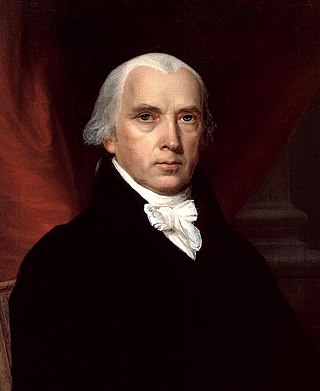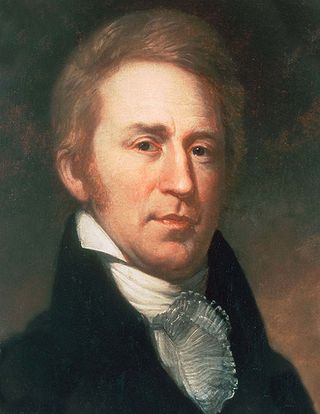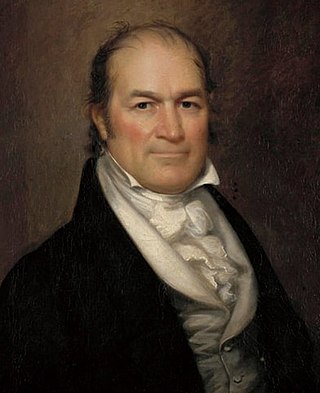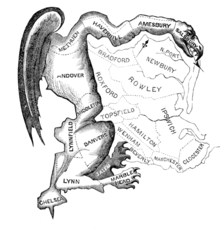
The Louisiana Purchase was the acquisition of the territory of Louisiana by the United States from the French First Republic in 1803. This consisted of most of the land in the Mississippi River's drainage basin west of the river. In return for fifteen million dollars, or approximately eighteen dollars per square mile, the United States nominally acquired a total of 828,000 sq mi in Middle America. However, France only controlled a small fraction of this area, most of which was inhabited by Native Americans; effectively, for the majority of the area, the United States bought the preemptive right to obtain Indian lands by treaty or by conquest, to the exclusion of other colonial powers.

1812 (MDCCCXII) was a leap year starting on Wednesday of the Gregorian calendar and a leap year starting on Monday of the Julian calendar, the 1812th year of the Common Era (CE) and Anno Domini (AD) designations, the 812th year of the 2nd millennium, the 12th year of the 19th century, and the 3rd year of the 1810s decade. As of the start of 1812, the Gregorian calendar was 12 days ahead of the Julian calendar, which remained in localized use until 1923.

The 1812 United States presidential election was the seventh quadrennial presidential election. It was held from Friday, October 30, 1812, to Wednesday, December 2, 1812. Taking place in the shadow of the War of 1812, incumbent Democratic-Republican President James Madison defeated DeWitt Clinton, the Lieutenant Governor of New York and Mayor of New York City, who drew support from dissident Democratic-Republicans in the North as well as Federalists. It was the first presidential election to be held during a major war involving the United States.

George Clinton was an American soldier, statesman, and Founding Father of the United States. A prominent Democratic-Republican, Clinton served as the fourth vice president of the United States from 1805 until his death in 1812. He also served as the first governor of New York from 1777 to 1795 and again from 1801 to 1804. Along with John C. Calhoun, he is one of two vice presidents to hold office under two consecutive presidents. He was also the first vice-president to die in office.

William Clark was an American explorer, soldier, Indian agent, and territorial governor. A native of Virginia, he grew up in pre-statehood Kentucky before later settling in what became the state of Missouri.

The 12th United States Congress was a meeting of the legislative branch of the United States federal government, consisting of the United States Senate and the United States House of Representatives. It met in Washington, D.C. from March 4, 1811, to March 4, 1813, during the third and fourth years of James Madison's presidency. The apportionment of seats in the House of Representatives was based on the 1800 United States census. Both chambers had a Democratic-Republican majority.

William Harris Crawford was an American politician and judge during the early 19th century. He served as US Secretary of War and US Secretary of the Treasury before he ran for US president in the 1824 election.

James Wilkinson was an American soldier, politician, and double agent who was associated with several scandals and controversies.

James Barbour was an American politician, planter, and lawyer. He served as a delegate from Orange County, Virginia, in the Virginia General Assembly and as speaker of the Virginia House of Delegates. He was the 18th Governor of Virginia and the first Governor to reside in the current Virginia Governor's Mansion. After the War of 1812, Barbour became a U.S. Senator and the United States Secretary of War (1825–1828).
Southern Democrats are members of the U.S. Democratic Party who reside in the Southern United States.

The Gutiérrez–Magee Expedition was an 1812–1813 joint filibustering expedition by Mexico and the United States against Spanish Texas during the early years of the Mexican War of Independence.
Allan Bowie Magruder was an American poet, historian, lawyer, and politician, who served as a United States Senator from Louisiana from September 3, 1812, to March 3, 1813.

The presidency of James Madison began on March 4, 1809, when James Madison was inaugurated as President of the United States, and ended on March 4, 1817. Madison, the fourth United States president, took office after defeating Federalist Charles Cotesworth Pinckney decisively in the 1808 presidential election. He was re-elected four years later, defeating DeWitt Clinton in the 1812 election. His presidency was dominated by the War of 1812 with Britain. After serving two terms as president, Madison was succeeded in 1817 by James Monroe, his Secretary of State and a fellow member of the Democratic-Republican Party.
Events from the year 1780 in the United States.
Events from the year 1804 in the United States.
Events from the year 1811 in the United States.
Events from the year 1813 in the United States.
Events from the year 1814 in the United States.
Events from the year 1815 in the United States. As news slowly spread of the Treaty of Ghent (1814) ending the War of 1812, battles between American and British forces continued in the early months of the year.

Events from the year 1846 in the United States. In this year, the United States declares war on Mexico, starting the Mexican–American War.
















